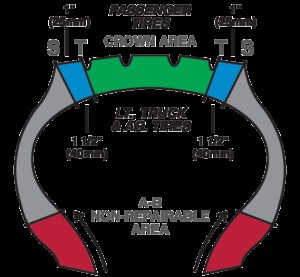Dealing with a flat tire can be an unexpected inconvenience. While quick fixes like tire plugs and strings might seem like a fast solution, it’s crucial to understand that these are only temporary measures. For a safe and lasting solution to tire damage, knowing how car tires are properly repaired is essential. This article will guide you through the differences between temporary and proper car tire repairs, ensuring you prioritize safety and longevity.
Temporary Tire Repairs: Plugs and Strings Are Not the Answer
Emergency plug and string repairs are often seen as convenient roadside fixes. They can quickly get you back on the road, but it’s important to recognize their limitations. These methods are designed merely to get you to a safe location or a professional service center where a proper tire repair can be performed. They are not intended as permanent fixes for your car tires.
A common misconception is that if a plug or string repair holds air, it’s a safe, long-term solution. While these repairs can effectively reinflate your tire and stop the immediate leak, they don’t address the underlying issue completely. The problem with plug-only repairs is that they often fail to create a complete seal of the tire injury. This incomplete seal can allow air and, more critically, moisture to seep into the tire’s structure. Over time, this penetration of moisture can degrade the internal components of the tire, potentially leading to a dangerous tire blowout. Such failures can have serious consequences, as highlighted by cases where improper tire repairs have led to significant accidents and legal repercussions.
Why Patch-Only Tire Repairs Fall Short
Similar to plug-only repairs, a tire repair using only a patch from the inside is also not considered a proper or safe long-term solution. A patch applied to the inner liner of the tire will typically hold air effectively, resolving the immediate air loss. However, the critical flaw with patch-only repairs is that, like plugs, they do not fill the puncture channel itself. This means that the pathway for air and moisture intrusion from the outside of the tire, through the tread, remains open. Consequently, even with a patch, moisture can still penetrate the tire body through the original injury channel, leading to eventual tire damage and potential failure.
The Gold Standard: The Proper Tire Repair Process
According to industry best practices, a proper car tire repair requires a combination patch and plug. This method is the only way to completely seal the puncture, both from inside the tire with a patch and through the entire injury channel with a plug. Following a structured process is key to ensuring a repair meets safety standards and prolongs the life of your tire. To simplify and remember the essential steps of proper tire repair, we use the acronym R.E.P.A.I.R.:
- Remove: The first critical step is to remove the tire from the wheel assembly. This is non-negotiable for a proper inspection and repair. Removing the tire allows for a comprehensive examination of both the interior and exterior of the tire to fully assess the damage.
- Evaluate: Once the tire is off the rim, a thorough evaluation of the puncture is possible. This involves determining the exact size, direction, and angle of the injury. Crucially, this step also assesses whether the puncture has caused any significant damage to the tire’s internal structure, such as the cords or belts. If these components are heavily damaged, the tire may not be repairable.
- Prepare: Assuming the tire is deemed repairable after evaluation, the preparation phase begins. This involves preparing the rubber surfaces around the injury, both inside and out, to ensure optimal adhesion of the repair unit. First, using a specialized carbide cutter, the injury channel is carefully drilled out from the inside to remove any damaged cords, belts, and debris. Next, the inner liner around the puncture area is cleaned and buffed to create a slightly rough texture. This roughening is vital as it significantly enhances the adhesion of the patch/plug repair to the tire’s inner liner.
- Apply: In this step, vulcanizing fluid is applied. This specialized adhesive is applied both through the prepared injury channel from the outside and to the buffed area on the inner liner. The vulcanizing fluid is then allowed to air dry for a period of 5 to 10 minutes. This drying time is crucial as it allows the fluid to become tacky, maximizing its bonding properties for the subsequent repair unit application.
- Install: The repair unit, which is typically a one-piece or two-piece patch-plug combination, is now installed. The plug portion is inserted through the injury channel from the inside, effectively filling the puncture. Simultaneously, the patch portion is applied to the prepared and vulcanized inner liner. Using a tire stitcher, the patch is then thoroughly stitched down, working from the center outwards to ensure complete contact and to eliminate any trapped air bubbles beneath the patch. After the patch is securely applied, the excess repair material protruding above the tread surface is trimmed down to approximately ¼ inch. Finally, the buffed area surrounding the patch on the inner liner is treated with a thin layer of rubber sealant to further ensure a complete and airtight seal.
- Return to Service: With the repair completed, the tire is now ready to be remounted onto the wheel rim. Following remounting, it is inflated to the correct pressure, balanced to ensure smooth driving, and then reinstalled on the vehicle. The tire is now properly repaired and ready to return to service.
Is Your Tire Repairable? Key Considerations for Tire Safety
 Repairable area of a car tire crown, illustrating the safe zone for puncture repairs on passenger vehicle tires, excluding sidewall and shoulder damage for safety.
Repairable area of a car tire crown, illustrating the safe zone for puncture repairs on passenger vehicle tires, excluding sidewall and shoulder damage for safety.
Even with the proper patch/plug method, not every punctured tire is safely repairable. Several factors determine whether a tire can be repaired, falling into three main categories:
- Puncture Location: For passenger car tires, repairs are only considered safe if the puncture is located within the crown area of the tire. Damage to the shoulder or, critically, the sidewall of a tire is not repairable. These areas experience too much flexing and stress, making repairs unreliable and unsafe.
- Puncture Size: The size of the puncture is also a limiting factor. For standard fabric-ply passenger and light truck tires, the maximum repairable puncture size is ¼ inch (6mm). For steel-belted light truck tires, as well as medium and heavy-duty truck tires, a slightly larger puncture size of up to 3/8 inch (10mm) may be repairable. Exceeding these size limits compromises the structural integrity of the repair.
- Overall Tire Condition: The general condition of the tire is paramount in determining repairability. Tires exhibiting excessive wear, showing signs of casing separation, or having sustained impact damage or other forms of significant deterioration may be deemed unsafe to repair. Attempting to repair a tire that is already compromised due to these conditions can lead to dangerous failures. For a more detailed understanding of which tire conditions are repairable versus non-repairable, resources like our blog post “Can Your Tire Be Repaired?” offer comprehensive guidance.
Conclusion: Prioritize Proper Tire Repair for Safety
Dealing with a flat or leaky tire is an inevitable part of vehicle ownership. While the temptation to opt for a quick, temporary fix might be strong, especially in emergencies, understanding the limitations and risks of these methods is crucial. Taking shortcuts when it comes to tire repair can compromise your safety and the safety of your passengers. Investing the time to ensure a proper tire repair, either by doing it yourself with the correct knowledge and tools or by seeking out a reputable tire repair shop trained in industry-standard procedures, is always the best course of action. Proper repair not only ensures your immediate safety but also contributes to the longevity and reliable performance of your tires.

